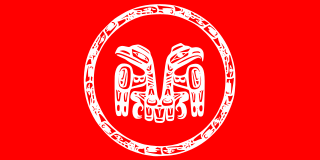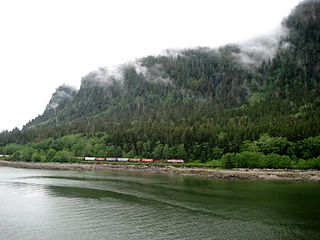
The Haida are an Indigenous group who have traditionally occupied Haida Gwaii, an archipelago just off the coast of British Columbia, Canada, for at least 12,500 years.

Haida Gwaii, also known as the Queen Charlotte Islands, is an archipelago located between 55–125 km (34–78 mi) off the northern Pacific coast of Canada. The islands are separated from the mainland to the east by the shallow Hecate Strait. Queen Charlotte Sound lies to the south, with Vancouver Island beyond. To the north, the disputed Dixon Entrance separates Haida Gwaii from the Alexander Archipelago in the U.S. state of Alaska.

Graham Island is the largest island in the Haida Gwaii archipelago, lying off the mainland coast of British Columbia, Canada. It is separated by the narrow Skidegate Channel from the other principal island of the group to the south, Moresby Island. It has a population of 3,858, an area of 6,361 km2 (2,456 sq mi), and is the 101st largest island in the world and Canada's 22nd largest island.

Haida is the language of the Haida people, spoken in the Haida Gwaii archipelago off the coast of Canada and on Prince of Wales Island in Alaska. An endangered language, Haida currently has 24 native speakers, though revitalization efforts are underway. At the time of the European arrival at Haida Gwaii in 1774, it is estimated that Haida speakers numbered about 15,000. Epidemics soon led to a drastic reduction in the Haida population, which became limited to three villages: Masset, Skidegate, and Hydaburg. Positive attitudes towards assimilation combined with the ban on speaking Haida in residential schools led to a sharp decline in the use of the Haida language among the Haida people, and today almost all ethnic Haida use English to communicate.

The North Coast Regional District is a quasi-municipal administrative area in British Columbia. It is located on British Columbia's west coast and includes Haida Gwaii, the largest of which are Graham Island and Moresby Island. Its administrative offices are in the City of Prince Rupert.

Skidegate is a Haida community in Haida Gwaii in British Columbia, Canada. It is on the southeast coast of Graham Island, the largest island in the archipelago, and is approximately 50 kilometres (31 mi) west of mainland British Columbia across Hecate Strait.
Port Clements is an incorporated village situated at the east end of Masset Inlet in Haida Gwaii off the coast of the Province of British Columbia in Canada. Known as Gamadiis in HlG̱aagilda X̱aayda kil, it is one of seven village sites that flourished in the rich waters at the mouth of Yakoun River, where an estuary shelters nine Pacific salmonid species and many kinds of birds. Founded by Eli Tingley in 1907, it was once known under the name Queenstown, but renamed to Port Clements in 1914 after Herb S. Clements, the local MP at the time, when the name "Queenstown" duplicated and therefore became unusable for the post office.
The Queen Charlottes Gold Rush was a gold rush in southern Haida Gwaii of what is now the North Coast of British Columbia, Canada, in 1851.

Skidegate Channel is a strait located in the Haida Gwaii archipelago of British Columbia, Canada. It divides the archipelago's two main islands, Graham Island to the north and Moresby Island to the south.
The Yakoun River is the largest river of Haida Gwaii, in the province of British Columbia, Canada. Located on Graham Island it flows about 58 km (36 mi) from Yakoun Lake north to Masset Inlet, a large saltwater bay located in the heart of the Graham Island and connected to the Pacific Ocean at Dixon Entrance via a long narrow inlet called Masset Sound.

Masset Inlet is a large saltwater bay located in the heart of the lowland of northern Graham Island, the northernmost and largest island of the Haida Gwaii islands on the North Coast of British Columbia, Canada. It is fed by several rivers, the largest of which is the Yakoun River, and is connected to the open sea of the Dixon Entrance by the narrow Masset Sound and Masset Harbour, which opens onto McIntyre Bay. The communities of Port Clements and Sewall are located on the shores of Masset Inlet. The community of Juskatla is located on Juus Ḵáahlii, the largest of Masset Inlet's arms. There are several islands in the inlet, the largest of which is Kumdis Island, at the inlet's egress to Masset Sound and just north of Port Clements. Masset Inlet helps form the isthmus of the Naikoon Peninsula.

Cumshewa is a former village of the Haida people located on the north flank of Cumshewa Inlet in the Haida Gwaii of the North Coast of British Columbia, Canada. It is named for Cumshewa, an important Haida chief during the era of the Maritime Fur Trade, as is Cumshewa Head, an important headland and point on the north side of the opening of Cumshewa Inlet, which pierces Moresby Island from the east and was the location of several historical Haida villages.
Cumshewa Inlet, also recorded or referred to in exploration logs as Cumchewas Harbour and Tooscondolth Sound, is a large inlet on the east coast of Moresby Island in the Haida Gwaii islands of the North Coast of British Columbia. The inlet was the site of various Haida villages, including Cumshewa, Tanu and Djí-gua. The name for the inlet was conferred in the days of the Maritime Fur Trade following a custom whereby captains named locations for the most important local chief, in this case Cumshewa, who figures in maritime fur trade vessel logs from 1787 onwards. In 1794 Cumshewa and his followers massacred the crew of the American trading vessel Resolution in Cumshewa Inlet.
Old Massett Village Council is a band government of the Haida people, located in Old Massett, on Haida Gwaii. Old Massett Village Council is one of two Canadian band governments for the Haida Nation, the other is the Skidegate Band Council. The main governing body of the Haida people is the Council of the Haida Nation.
The Skidegate Band Council, also known as the Skidegate First Nation, is a band government of the Haida people, one of two of the Haida Tribal Society aka the Council of the Haida Nation. Its offices are located in Skidegate, British Columbia.
Hiellen, anglicized from the Haida name Tlielang, and also spelled in various ways such as Hliiyalang (Bringhurst) and Łi'elᴀñ (Swanton), was a historic Haida village located on the northern shore of Graham Island, at the mouth of the Hiellen River, across the river from Taaw Tldáaw, in Haida Gwaii, British Columbia, Canada.

Skidegate Inlet is a broad inlet on the east coast of the Haida Gwaii archipelago of the North Coast of British Columbia, Canada. It is the easternmost of a series of waterways separating Graham Island to the north from Moresby Island to the south.

Tanu is a traditional Haida village site located on Tanu Island, Haida Gwaii, opposite of Kung'a Island in Laskeek Bay, within the Gwaii Haanas National Park Reserve and Haida Heritage Site.
Kiusta located on Haida Gwaii is the oldest Northern Haida village: and the site of first recorded contact between the Haida and Europeans in 1774. Haida lived in this village for thousands of years, due to the sheltered nature of its location it was used for boats offloading, especially in rough waters. Kiusta is one of the oldest archeological sites of human use in British Columbia, and continues to be a site for cultural revitalisation.

Various Imperial and colonial actions against Haida Gwaii Authorities have been undertaken since the 19th century. The indigenous peoples of Haida Gwaii often reacted violently to European and American ships which trespassed in their waters and lands. From the 18th to 19th centuries, various skirmishes took place between Haida authorities and European and American merchantmen and warships. Canadian settlers did not arrive on Haida Gwaii islands until 1900, and many Canadian colonial police actions attempted to assault the Haida Gwaii authorities and citizens. The indigenous Haida population was decimated by diseases such as smallpox which were introduced accidentally by way of Fort Victoria. The presence of foreign diseases, to which the Haida had no immunity, along with some colonial hostility, meant that the numbers of Haida citizens was reduced from tens of thousands to 588 by 1915. This erosion of Haida cultural institutions was essential to open the way for subsequent British and Canadian incursions and jurisdictional claims.












